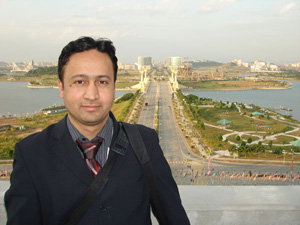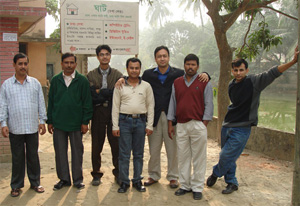|
Spreading the bounty and promise of the Information Age to the far corners of the world is a primary objective of the University of Washington’s Information School. One recent iSchool alumnus is putting that theory into action in his native country of Bangladesh.
Tariq Alam (’03), a member of the first cohort of the Master of Science in Information Management (MSIM) program, is now the managing director of the Digital Equality Network (DEN), which is establishing information technology (IT) services for businesses and individuals in rural parts of his country. Alam, who also holds a bachelor’s in engineering from Khulna University of Engineering and Technology in Bangladesh, refers to himself as a “social business entrepreneur,” devoting his professional career to providing information technology solutions for business improvement and social development in developing nations. In 1999, he designed and implemented a Village Computer and Internet Program (VCIP) in Bangladesh that familiarized rural people with computers and the Internet by providing access and training. He later designed and developed web pages, software and training programs on computer technology for Grameen Bank, the financial institution that along with founder Muhammad Yunus won the Nobel Peace Prize in 2006 for providing credit without collateral to the poorest of the poor in rural Bangladesh.
Alam’s latest venture aims to develop an information infrastructure in Bangladesh, which will in turn encourage social change and develop a knowledge-based society. “DEN promotes business and enhances organizational capacity by supplying appropriate IT-enabled services (such as Internet access, e-mail and digital recording) and creating partnerships with local information centers and other community organizations for better service delivery,” he explains.
Historically, information plays a key role in promoting business and economic development, and the explosion in communications capabilities can accelerate the process. “Information technology has the power to connect people across boundaries and provide wider access to information,” Alam says. “In the past 10 years, discourse all over the world has centered on how rural people can get access to telecommunications, the Internet and information. In Bangladesh, several mobile phone companies began operations, making it possible to connect rural people throughout the country. With advances in mobile data technology, now these operators are focusing on providing access to the Internet for businesses and individuals. But providing information services is not merely providing access to the Internet or even to information in general. It is more about understanding how to build information services in a holistic manner with strategies for sustainable service delivery.”
|
DEN, with the support of Katalyst, a donor consortium comprising the United Kingdom’s Department for International Development (DFID-UK), the Swiss Agency for Development and Cooperation (SDC) and the Swedish International Development Cooperation Agency (SIDA), established the first two of its rural tele-centers in 2005. Called GHATs (Global House of Advanced Technology), each serves as a regional information clearinghouse and provides IT-enabled services to the rural business community in its region. “Interestingly, "ghat" is also a Bangla word that means a place of people gathering for marketing rural products and traveling to other places by boat,” Alam explains. “GHAT is a very popular and catchy word at the rural level.
“Each GHAT seeks to create a process for developing and promoting information services in particular and IT-enabled services in general,” he continues. “After successful operation, the GHAT tele-center becomes a self-sustainable business model. We hope to establish more than 30 GHATs in 2007 and plan to cover most of rural Bangladesh by the end of 2008.”
The GHAT tele-centers begin by providing the information needed most by their rural constituents, mainly in the areas of agriculture, citizen issues and business practices. This would include market price changes, what fertilizers to use, and what government services are available to businesses, for example. Focusing initially on poultry farming, fisheries and crops such as potatoes, plus educational and governmental services, the centers will gradually expand the areas of information they dispense.
Promotion of their services and delivery of the information, however, can pose more significant hurdles. “Physical infrastructure such as electrical and telephone service and technology support are poor in a developing country like Bangladesh,” Alam points out. “If a personal computer or an Internet connection encounters a problem, in rural areas it becomes a hassle to solve it. Information services cannot be completely dependent on technology; they must have both a technology-dependent (digital) service mode and a non-technology-dependent (analog) service mode.
“In order to deliver information services to a community where people are not used to using technology and have limitations in accessing technology, we must combine a high-tech and low-tech approach,” he adds. “Thus a GHAT ‘info-mediator’ (a mobile employee) collects ‘information product’ (usually a printed handout) from a GHAT tele-center and then uses a bicycle to reach the door of the ultimate recipient. The technology that developed the information product is high-tech, but the bicycle is low-tech, and these two are equally important to complete the service delivery cycle.”
In their first year of operation, the two GHAT tele-centers have already proven that rural people need current information and can use it to their advantage. The challenge is to develop need-based information and deliver it through appropriate means.
To do that, Alam is implementing a “4i model” of information services that he learned about in his graduate studies at the iSchool. “We group information into four major domains based on its nature and how it fulfills customer need: Information that fills an immediate gap--the Informing domain; Information that assists personal need--the Inspiring domain; Information that solves a technical problem--the Involving domain; and Information that motivates change--the Improving domain,” Alam explains. “Using the 4i model allows us to gain a more comprehensive understanding of information needs in rural areas and of business reality in a rural setting. It helps to identify information needs, develop information products and deliver information services in a financially sustainable business model.”
Developing this kind of information infrastructure and organization is exactly the kind of endeavor Alam had in mind when he applied to the fledgling MSIM program in 2001. “I hope MSIM will help me understand the social aspects of information technology and social responses to it, to understand the information system development process, to understand and design data communications and networking systems, to learn different aspects of management of IT projects and information organization, and to understand how information management systems can impact socio-economic development,” Alam wrote in his application at that time. “My professional career goal is to establish an IT-based, nonprofit organization for social development. I would like to design and develop information technology infrastructure for rural Bangladesh and provide information services to rural people, which will help to create an information-based society and empower people to contribute to socio-economic development.”
Spring 2007 | Return to eNews Bulletin Home




